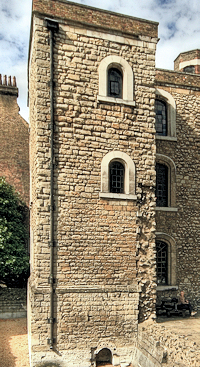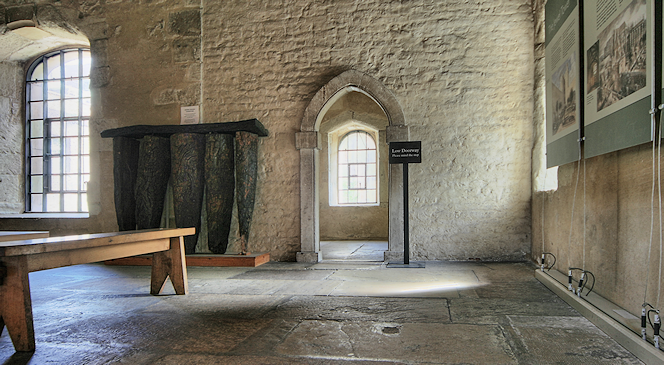Jewel Tower
Surviving annex of Westminster’s medieval palace
Jewel Tower, Abingdon Street, Westminster

This is not the repository of the Crown Jewels, which are stored in the Jewel House (formerly also known as the Jewel Tower) at the Tower of London. However, Westminster’s Jewel Tower was originally built to accommodate the royal valuables, as a branch of the King’s Privy Wardrobe.
On the recommendation of William Usshebourne (or de Husseborne), keeper of the Privy Palace, Edward III appropriated a plot of land from Westminster Abbey and raised an L‑shaped tower with a polygonal stair-turret on the north side, surrounded by a moat that would provide protection from fire and thieves. The tower was designed by Henry Yevele, the leading architect of the day, and built in 1364–6 from Kentish rag-stone, 98 boatloads of which were shipped from Maidstone. Usshebourne stocked the moat with freshwater fish and is said to have choked to death while eating a pike caught there. The abbey’s monks apparently took a somewhat unseemly delight in this tragedy, which they were convinced was a retributive act of God.
One room of the Jewel Tower was briefly used as a prison in 1450 when the Duke of Suffolk was transferred here from the Tower of London, where he had been held on a charge of treason. The Jewel Tower made for a comparatively comfortable jail-house and was conveniently located for visits from sympathetic members of the House of Lords. The considerate nature of this transfer was perhaps a reflection of the weakness of the evidence against the duke and the charge was soon dropped.
After a fire at the palace in 1512, when Henry VIII abandoned Westminster, the majority of the royal jewels were moved elsewhere and the tower became a storehouse for the king’s plentiful collection of apparel. From the end of the 16th century the Jewel Tower was used by the House of Lords as a depository for Parliamentary rolls and the level of protection was enhanced in 1619 by the addition of a fireproof strongroom on the first floor. This had the providential consequence of preserving the Lords’ records when the Palace of Westminster burned down.
By the early 18th century the upper part of the tower was in a dilapidated state and it was restored in 1718 under the aegis of the clerk of works for Westminster, Nicholas Hawksmoor, who also had the windows reshaped, giving them round arches.
In 1864 the Parliamentary documents were moved to the new Palace of Westminster’s Victoria Tower and the Jewel Tower subsequently served as the Office of the Standards Department, housing the official weights and measures. The tower was damaged during the Second World War, and was afterwards restored and opened to the public. Its features include 13th-century ceiling carvings from the old Palace of Westminster, an unaltered 14th century ribbed vault and exhibitions of historic weights and measures and on the the history of Parliament.
Since 2013 an exhibition covering all three floors of the Jewel Tower has highlighted its history and changing role over the centuries. Features include a model of the medieval palace of Westminster, replicas of precious objects and areas of set dressing, including an 18th-century clerk’s office.


